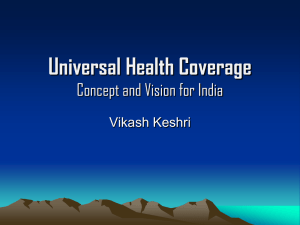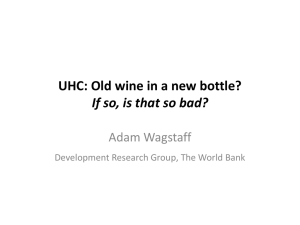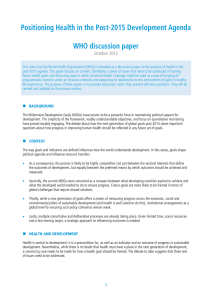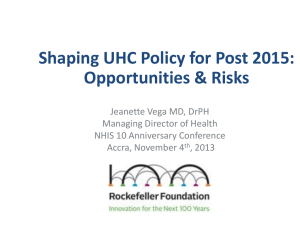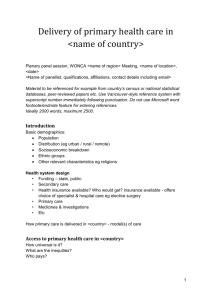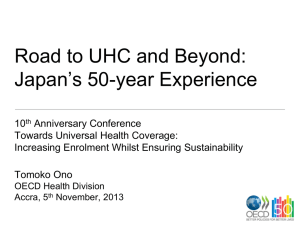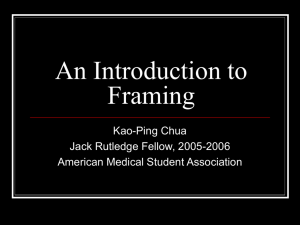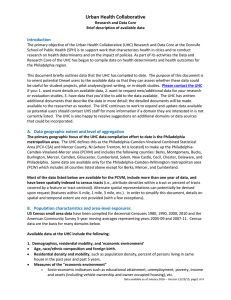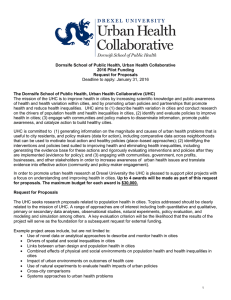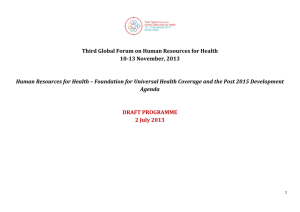UHC - Healthfirst Network
advertisement
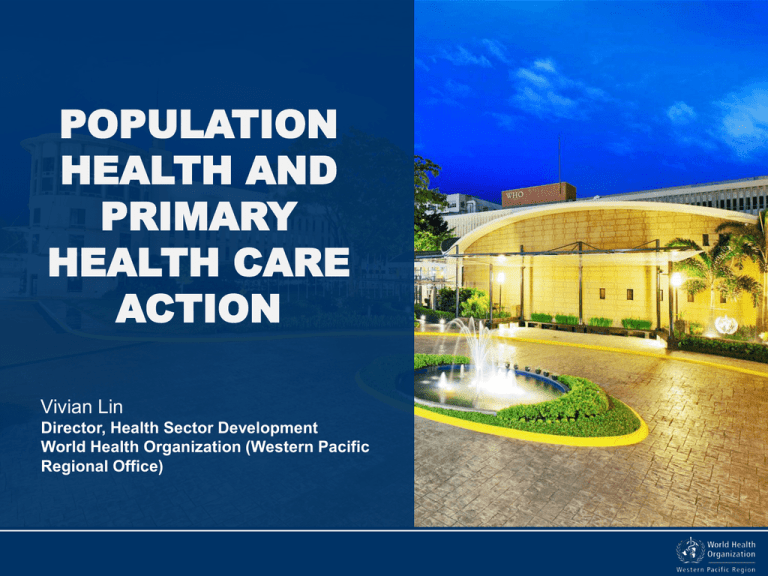
POPULATION HEALTH AND PRIMARY HEALTH CARE ACTION Vivian Lin Director, Health Sector Development World Health Organization (Western Pacific Regional Office) Providing an international perspective • From PHC to UHC • Post 2-15 Development Agenda and Universal health coverage (UHC) • Reviewing Community-oriented Primary Care • Population health planning for primary health care • Moving to integrated, partnership-based approach • Conclusion 2 Universal Health Coverage PHC–based health system • an overarching approach to the organization and operation of the health system • makes the right to the highest attainable level of health its main goal • maximizes equity and solidarity 3 3 Universal Health Coverage PHC–based health system • Composed of a core set elements that guarantee universal access to services that are: – acceptable to the population – equity-enhancing • Provides comprehensive, integrated, and appropriate care over time • Emphasizes prevention and promotion, and assures first contact care • Families and communities are its basis for planning and action 4 4 Universal Health Coverage Experience says PHC works International evidence suggests that health systems based on strong PHC orientation – have better and more equitable health outcomes – are more efficient – have lower costs – achieve higher user satisfaction than health systems with only weak PHC 5 5 Universal Health Coverage PHC transformed into UHC? • 2008 World Health Report – renewal of primary health care – need for health systems to respond better and faster to changing health challenges • 2010 World Health Report – health financing – to achieve universal health coverage and improve population health outcomes 6 Universal Health Coverage THE POST-2015 DEVELOPMENT AGENDA • High-level Eminent Persons Panel pillars for development – leave no one behind, inclusive growth, sustainable development, good governance, quality of life • Health related aspects: – Complete MDGs – NCDs – UHC 7 Universal Health Coverage What is Universal Health Coverage (UHC)? • Access to good quality of needed services – Prevention, promotion, treatment, rehabilitation and palliative care • Financial protection – No one faces financial hardship or impoverishment by paying for the needed services. • Equity – Everyone, universality 8 Universal Health Coverage Three Dimensions of UHC UHC contributes to good health and beyond… • UHC improves or maintains health through coverage for needed services. • UHC contributes to poverty reduction. – Good health enables adults to earn income and children to learn, giving them more opportunities to escape from poverty. • UHC is a vehicle to build social solidarity, national pride and trust in the government. • UHC offers a way of sustaining gains and protecting investments in the current set of healthrelated MDGs. 10 Universal Health Coverage UHC – core to WHO work • UHC in WHO’s history WHO's constitution (1948) Alma-Ata Declaration (1978) WHR on Primary Health Care (2008) WHR on Health Systems Financing-The Path to Universal Coverage (2010) Rio Declaration on SDH (2011) UN High-level Meeting on NCDs (2011) 11 • Post-2015 Agenda – All countries (rich or poor) can make progress – Offers a way of sustaining gains and protecting investments of health-related MDGs – Accommodates the changing agenda for global health and other internationally agreed health goals, such as NCDs – Concerns health equity and the right to health • Independent of post 2015 agenda, UHC remains core to WHO work Universal Health Coverage (UHC) Affordability Financial protection Quality Accessibility Equity High quality people-centered and integrated interventions Acceptability Services Availability COMMUNITY-ORIENTED PRIMARY CARE AT THE CORE KEY PRINCIPLES • Use epidemiological and clinical skills • Address determinants and consequences of health and illness • Concern with environment/ family/ individual; with health services and behaviors 13 IDEAL FEATURES • Population - identified community • Governance - allow community involvement • Information - facilitate planning and evaluation • Funding - incentives for costeffective services • Workforce - team-based, combine public health and clinical medicine skills • Service - comprehensive, coordinated, consumer focused COPC= Partnership between Population Health and Clinical Services Target Type of Function (1) Primary Generalised - population Pop Health Secondary Tertiary Pop Health Pop Health Generalised - individuals PH/ClinicalMed PH/CM PH/CM Selective ? PH/CM PH/CM Indicated PH/CM PH/CM Clinical Medicine Source: Starfield (1996:1368) PH = Public Health; CM = Clinical Medical Care (1) Primary = intervention to prevent a problem from occurring; Secondary = intervention at a stage before a problem is manifested; Tertiary = remediation to reverse manifestations of problem INTERVENTIONS BY FUNCTION AND TARGET GROUP Target Type of Function (1) Primary Secondary Tertiary Generalised population Generalised individuals Environmental planning Health education, immunisation Legal redress or social welfare Surveillance systems Selective (population risk factors) Indicated (known predisposition) ?genetic engineering Product safety monitoring Breast and cervical cancer screening Blood lead screening Prophylactic antibiotics Follow-up after disease Quality assessment of clinical services Home visiting Source: Adapted from Starfield (1998:328) (1) Primary = intervention to prevent a problem from occurring; Secondary = intervention at a stage before a problem is manifested; Tertiary = remediation to reverse manifestations of problem A partnership-based PHC system Community Nutrition Environmental Health Dietary Advice Communicable Disease Counselling Control Clinical Mental Health Promotion Care Child Health Early Childhood Development Social Work Community Nursing Home Support Community Development HEALTH NEEDS – Central to population health planning and prevention • Groups! – health is not randomly distributed • People live, work and play in context – demographic, social, economic, cultural factors matter • Objective measures + subjective status – perceptions are realities • Health hazards and risks – present and future • Relativities - comparison with peer communities/population groups 17 Universal Health Coverage PLANNING FOR POPULATION HEALTH • Starting points: – Health: diseases and conditions (eg diabetes, cancer, mental health), risk factors (eg alcohol, tobacco, physical inactivity), protective factors (eg social support) – People: children, older people, ATSI, CALD communities, homeless – Places and settings: localities, schools, workplaces • Outcomes: health improvement; disease prevention; health maintenance; quality of life 18 Universal Health Coverage CONTRASTING MODELS OF HEALTH PLANNING Population-based Institution-based 1. Select health issue 1. Select health service 2. identify risks 2. determine current demand 3. evaluate population risk level 3. forecast future demand 4. compared need with current program 5. adjust resources 6. evaluate 19 4. compare demand with current capacity 5. adjust resources 6. evaluate NEEDS ASSESSMENT Analyse information and confirm key issues Collect qualitative data Collect quantitative data Stakeholder consultation Determine strategic issues and missing information 20 Universal Health Coverage Analyse problem and review evidence A PLANNING TAXONOMY LIFE COURSE children youth Young adult Middle aged Older adults Health promotion Disease prevention Early detection and intervention Episodic and acute care Sub-acute care and rehabilitation Long term care Palliative and terminal care Population Health Model Care Coordinated Self-managed At Risk Population Well Population POPULATION HEALTH AND THE CARE CONTINUUM Well Population 23 At Risk • Community -based programs • Screening • Primary prevention • Secondary prevention • Early intervention Universal Health Coverage Living with controlled chronic disease Uncontrolled chronic disease • Selfmanagement • Casecoordination • Continuing care • Complications management Tertiary prevention & Disease management UTLISATION AND SERVICE SYSTEMS – understanding from population perspective • Diverse patient journeys • Falling through the cracks • Parallel primary care systems • Financial, cultural, psychological barriers to care seeking • Level of health literacy 24 Universal Health Coverage Social Determinants of Health 25 Universal Health Coverage DEVELOPING STRATEGIES AND SELECTING INTERVENTIONS • Ottawa Charter a useful checklist: – Healthy public policy – Supportive environment – Community action – Personal skills – Health services • Review evidence and consider applicability, gaps in current system, and scale needed to effect change (population strategy vs individual strategy) • Weigh up options using multiple criteria, ensuring acceptability, feasibility, and cost-effectiveness (or return on investment) are considered • Use multi-voting amongst stakeholders 26 Universal Health Coverage Essential Packages of Services - MCH Pre-pregnancy Pregnancy Birth Postnatal Neonatal Infancy Childhood Promoting breastfeeding Promotion of healthy lifestyle (alcohol, diet, smoking, physical activity, etc.) Antenatal care Safe Postpartum delivery care Management of childhood illness Vitamin A, micronutrients Deworming Immunization Insecticide-treated nets and indoor residual spraying Improved sanitation, Better nutrition and food access, and Health protection Housing, Education, Employment, Early childhood 27 development, Empowerment of women and gender equity 27 Address service coverage gaps Pre-pregnancy Pregnancy Birth Postnatal Neonatal Infancy Childhood 100 G A P 80 G 60 A 50 40 P 20 0 28 28 PARTNERSHIPS – Coordinated service delivery and action on social determinants of health • Health services • Social services • Local government • Community and consumer/patient organisations • Private sector • Frontline staff 29 Universal Health Coverage Need for Integrated/Coordinated Service Delivery • People experience multiplicity of issues multiple determinants have multiple outcomes, and clustered in localities and populations • Shared interests and objectives at service delivery level (operational/informational needs, common clients and partners) • Co-benefits across service providers and sectors 30 Universal Health Coverage Possible approaches for coordination and integration • Clustering of health issues • Linking of service providers • Settings as basis for intervention • Population groups as frame of reference • Clinical care and public health partnership 31 Universal Health Coverage Organisational Shifts (Marquardt) Dimensions Bureaucratic Structure Hierarchical Boundaries Fixed Permeable Focus Institution Client Network Teams and alliances Management Command and Participative style control Culture Compliance Outcomes GOVERNANCE – Managing the networks and the course of events • Participation ladder: information – consultation – collaboration – ownership • Who participates – advisory or decision-making? Who decides in the first place? Accountability to whom? And how? • Successful partnerships – safe environment, clear decision-making procedures, focus on joint priorities, win-win, draw on complementarities, share the credit 33 Universal Health Coverage CONCLUSION: THE UHC/PHC IDEAL

